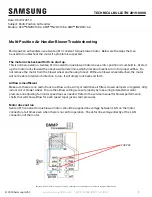
Page 27
System Performance
This equipment is a self-contained, factory optimized
refrigerant system, and should not require adjustments to
system charge when properly installed. If unit performance
is questioned, perform the following checks.
Ensure unit is installed per manufacturer’s instructions and
that line voltage and air flow is correct. Refer to Tables 6
through Table 8 for proper performance value. The indoor
metering device varies by model.
If the measured performance value varies from table value
allowance, check internal seals, service panels and duct
work for air leaks, as well as restrictions and blower speed
settings. If unit performance remains questionable, remove
system charge, evacuate to 500 microns, and weigh in
refrigerant to nameplate charge. It is critical that the exact
charge is re-installed. Failure to comply will compromise
system performance.
If unit performance is still questionable, check for
refrigerant-related problems, such as blocked coil or
circuits, malfunctioning metering device or other system
components.
Maintenance – LRP16HP
Before performing maintenance operations on the
system, shut off all electrical power to the unit. Turn off
accessory heater power switch if applicable. Electrical
shock could cause personal injury or death.
WARNING
Periodic inspection and maintenance normally consists of
changing or cleaning the filters and cleaning the evaporator
coil. On occasion, other components may also require
cleaning.
Filters
Filters are not supplied with the unit. Inspect once a month.
Replace disposable or clean permanent type as necessary.
Do not replace permanent type with disposable.
Motors
Indoor and outdoor fan and vent motors are permanently
lubricated and require no maintenance.
Some models may be equipped with a permanent magnet,
constant torque indoor blower motor. These motors remain
energized and are controlled by 24V signals. For high
static applications, use tap 3 for cooling speed and tap 5
for heating speed. Refer to the heater installation label for
limitations to blower tap selection on heating speeds.
Evaporator Coil
Dirt and debris should not be allowed to accumulate on
the evaporator coil surface or other parts in the air circuit.
Cleaning should be as often as necessary to keep coil
clean. Use a brush, vacuum cleaner attachment, or other
suitable means. If water is used to clean the coil, be sure
the power to unit is shut off prior to cleaning.
Care should
be used when cleaning the coil so that the coil fins are
not damaged.
Do not permit the hot condenser air discharge to be
obstructed by overhanging structures or shrubs.
Condenser Coil
Clean condenser coil annually with water and inspect
monthly during the cooling season.
Condenser coil may need to be cleaned at startup in
case oil from the manufacturing process is found on the
condenser coil.






































